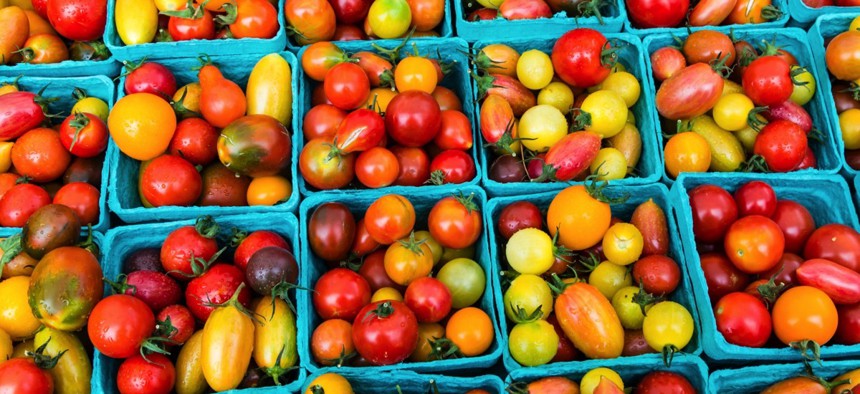This Might Be One of the Most Accessible Farmers Markets in the U.S.

Zigzag Mountain Art

Connecting state and local government leaders
From WIC and senior vouchers to SNAP/EBT benefits and “bonus bucks,” everything flies in Catawba County, North Carolina.
City and county governments nationwide are finding that creating better access to farmers markets can lead to innovations in public services related to a seemingly simple local activity: buying local produce and other agricultural products.
Catawba County, North Carolina, arguably has what might be the country’s most accessible farmers market.
The county-sponsored market, started in 2013, is in Hickory, which was designated as a U.S. Department of Agriculture-defined food desert.
The Catawba County Public Health Farmers Market partnered with the federal Women, Infants and Children Farmers’ Market Nutrition Program to increase residents’ consumption of fresh, locally grown fruits and vegetables.
“One of our goals for the Farmers Market is to increase the rate of redemption of WIC Farmers Market vouchers,” county WIC Director Julie Byrd said in a statement. “Following the market’s second season, the WIC program had the highest redemption rate, 64.37 percent, of Farmers Market Nutrition Program vouchers in North Carolina in 2014.”
While the WIC FMNP serves at-risk pregnant and post-partum women, infants and children through age 5, the farmers market became the first in the county to accept the Supplemental Nutrition Assistance Program benefits of low-income individuals and families in 2014.
The Electronics Benefit Transfer system streamlines the process by allowing shoppers to transfer their government benefits from a federal account to vendor accounts with the swipe of a card—accounting for $1,868 of the money spent by 4,586 customers between 11 farmers during 17 market days.
Of SNAP/EBT customers surveyed, 84.4 percent said the farmers market increased the fresh produce their families ate, and 73 percent credited the technology, according to the 2014 State of the County’s Health Report. County health officials will help other local farmers markets implement the technology in 2015.
Senior Farmers Market Nutrition Program vouchers are also accepted, and Catawba’s market uses “bonus bucks” in the form of $4 coupon to convince WIC clients to spend their vouchers at the market. An additional $1,056 in produce was available to 264 clients because of the corporate and privately funded program.
Farmers markets across the country have been embracing WIC vouchers and EBT cards in recent years.
Two locations in Moses Lake, Washington, will start taking them later this year with the financial support of the Grant County Health District and various other partners, the Columbia Basin Herald reported last week.
Both farmers markets also now offer a “Market Match Program,” where customers state how much of their benefits they’d like to spend and staff matches up to $10 in redemptions with $1 free certificates to be spent on SNAP-eligible food.
In Lee County, Illinois, select farmers markets will begin offering WIC voucher booklets in July, according to SaukValley.com.
As of April 10, Illinois has the sixth-highest number of WIC participants in the U.S. at 260,972, according to data from the U.S. Department of Agriculture Food and Nutrition Service. North Carolina comes in seventh with 255,595 participants.
The Catawba County Public Health Farmers Market won a 2014 National Association of Counties Achievement Award and, more recently, beat out about 80 other submissions for the Alliance for Innovation’s top J. Robert Havlick Award for Innovation in Local Government, presented Monday at the Transforming Local Government Conference in Phoenix.
With no signs of slowing down, the markets in Catawba County and Lee County only expect more interest as word of their accessibility spreads.
"You have to educate the client," Laurie Geuther, who runs Lee County’s WIC program, told SaukValley.com. "The first year was slow, and the second picked up a little, but now they look forward to the farmers’ market vouchers.”

NEXT STORY: Rescue workers use apps to help save lives





